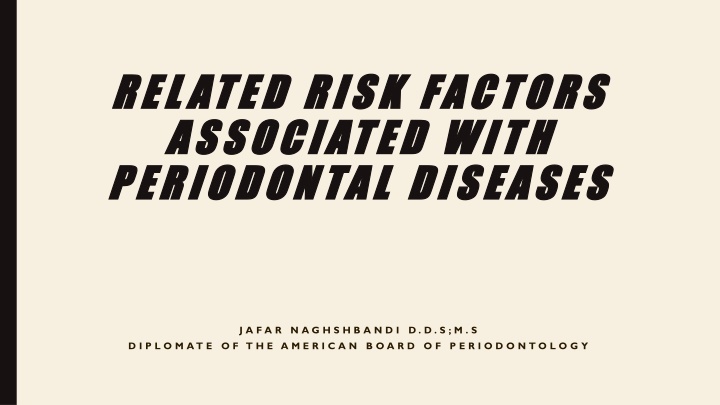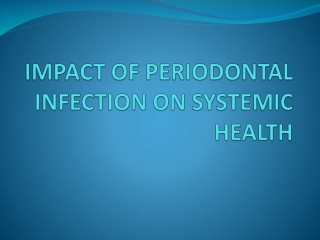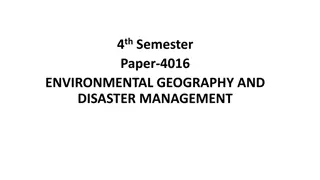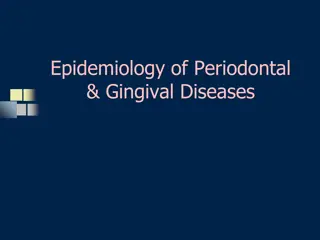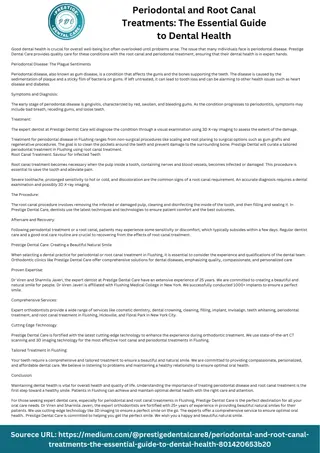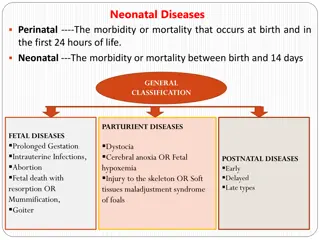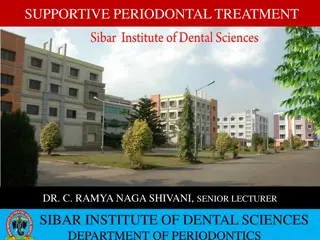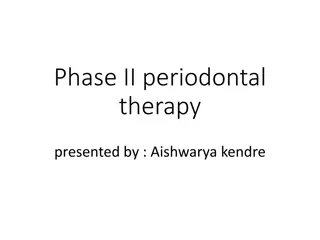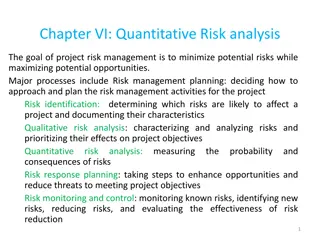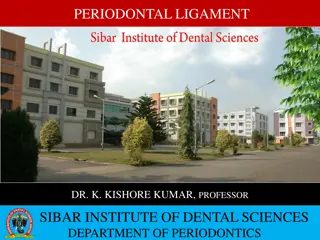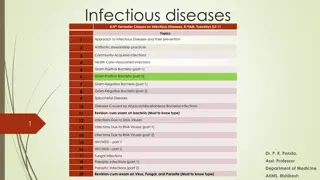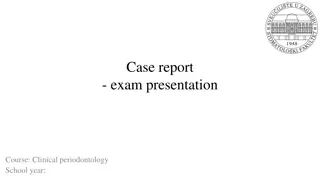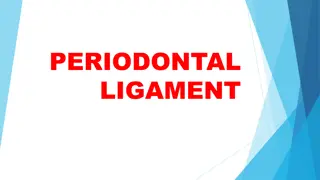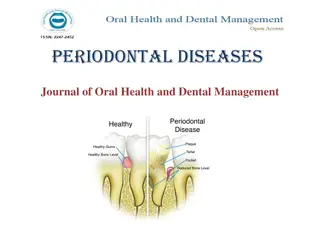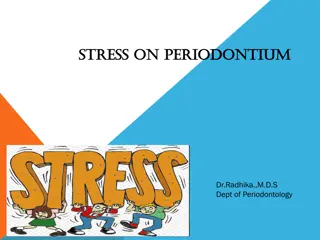Risk Factors Associated with Periodontal Diseases
Risk factors associated with periodontal diseases include tobacco smoking, diabetes, pathogenic bacteria, anatomic factors, and genetic factors. Age can also influence susceptibility to periodontitis due to prolonged exposure to risk factors over time. Risk assessment is crucial for identifying predisposing elements and managing disease progression.
Download Presentation

Please find below an Image/Link to download the presentation.
The content on the website is provided AS IS for your information and personal use only. It may not be sold, licensed, or shared on other websites without obtaining consent from the author.If you encounter any issues during the download, it is possible that the publisher has removed the file from their server.
You are allowed to download the files provided on this website for personal or commercial use, subject to the condition that they are used lawfully. All files are the property of their respective owners.
The content on the website is provided AS IS for your information and personal use only. It may not be sold, licensed, or shared on other websites without obtaining consent from the author.
E N D
Presentation Transcript
RELATED RISK FACTORS RELATED RISK FACTORS ASSOCIATED WITH ASSOCIATED WITH PERIODONTAL DISEASES PERIODONTAL DISEASES J A F A R N A G H S H B A N D I D . D . S ; M . S D I P L O M AT E O F T H E A M E R I C A N B O A R D O F P E R I O D O N T O L O G Y
SPECIAL THANKS WHOEVER TAUGHT ME A WORD MADE ME HIS SERVANT. Dr. Jim Simon Dr. Raul Caffesse
DEFINITION DEFINITION Risk is the probability that an individual will get a specific disease in a given period which may vary from one individual to other. Risk assessment involves identifying elements that either may predispose a patient to developing periodontal disease or may influence progression of disease that already exists.
RISK FACTORS FOR PERIODONTAL DISEASE RISK FACTORS FOR PERIODONTAL DISEASE 1. Tobacco smoking: Smoking has a negative impact on response to therapy. 2. Diabetes: Prevalence and severity is higher in diabetes than in those without diabetes. 3. Pathogenic bacteria and microbial tooth deposits: Quantity of plaque present on teeth is not of major importance. Composition or quality of the plaque biofilm is of importance. In terms of plaque, three specific bacteria have been identified as etiologic agents: a. Actinobacillus actinomycetemcomitans b. Porphyromonas gingivalis c. Bacteroides forsythus
ANATOMIC FACTORS ANATOMIC FACTORS Such as furcation, root concavities, developmental grooves, cervical enamel projections, enamel pearls and bifurcation ridges. All predispose to periodontitis, as they harbour bacterial plaque and present a challenge to clinician during instrumentation. Presence of calculus: It serves as a reservoir for bacterial plaque.
RISK DETERMINANTS/BACKGROUND CHARACTERISTICS FOR PERIODONTAL DISEASE It is defined as those risk factors that can not be modified. 1-Genetic factors: Genetic factors influence clinical measures of gingivitis probing pocket depth, attachment loss and interproximal bone height.
RISK DETERMINANTS/BACKGROUND CHARACTERISTICS FOR PERIODONTAL DISEASE 2-Age: Attachment loss and bone loss seen in elderly individuals is a result of prolonged exposure to other risk factors over a longer period of time. Changes related to old age such as intake of medications, decreased immune functions and altered nutritional status may increase susceptibility to periodontitis.
RISK DETERMINANTS/BACKGROUND CHARACTERISTICS FOR PERIODONTAL DISEASE 3-Gender: Males have more attachment loss than females and have a poorer oral hygiene therefore more males are prone to periodontal diseases.
RISK DETERMINANTS/BACKGROUND CHARACTERISTICS FOR PERIODONTAL DISEASE 4-Socio-economic status: Poor oral health is seen in lower socio-economic status. This can be attributed to: 1. Decreased dental awareness 2. Decreased dental visits.
RISK DETERMINANTS/BACKGROUND CHARACTERISTICS FOR PERIODONTAL DISEASE 5. Stress: Incidence of ANUG increases during stressful situations. Emotional stress may interfere with normal immune function. There is an apparent link between psychosocial factors and risk behavior such as smoking, poor oral hygiene and chronic periodontitis. Individuals with financial strain, distress, depression and inadequate coping mechanisms have more loss of attachment.
RISK INDICATORS FOR PERIODONTAL DISEASE RISK INDICATORS FOR PERIODONTAL DISEASE Risk indicators are probable or putative risk factors that have been identified in cross-sectional studies but have not been confirmed through longitudinal studies.
RISK INDICATORS FOR PERIODONTAL DISEASE RISK INDICATORS FOR PERIODONTAL DISEASE 1-HIV / acquired immunodeficiency syndrome: It has been hypothesized that immune dysfunction associated with high HIV infection and AIDS increases the susceptibility to periodontal disease, though the evidence is not conclusive.
RISK INDICATORS FOR PERIODONTAL DISEASE RISK INDICATORS FOR PERIODONTAL DISEASE 2-Osteoporosis: Osteoporosis does not by itself initiate periodontitis, there is reduced bone mass in osteoporosis, this may enhance the progression of periodontal disease.
RISK INDICATORS FOR PERIODONTAL DISEASE RISK INDICATORS FOR PERIODONTAL DISEASE 3-Infrequent dental visits: Some studies have shown increased risk for severe periodontitis in patients who have not visited dentist for 3 or more years (although age factor also plays a role).
RISK MARKERS/PREDICTORS RISK MARKERS/PREDICTORS These are associated with increased risk for disease, but do not cause the disease. A risk factor that can be used to predict the future course of disease, is known as a risk marker. 1. Previous history of periodontal disease. 2. Bleeding on probing: Bleeding on probing along with increased pocket depth may serve as an excellent predictor for future loss of attachment.
CLINICAL RISK ASSESSMENT FOR PERIODONTAL DISEASE CLINICAL RISK ASSESSMENT FOR PERIODONTAL DISEASE Demographic Data Age: Duration of exposure to the risk elements. Postmenopausal women Evidence of aggressive disease Gender: Males Frequency of care and preventive practices. Socio-economic status: Dental awareness Frequency of care Medical History The following conditions either predispose or make the patient more susceptible to periodontitis. Diabetes Tobacco smoking HIV/AIDS Osteoporosis Stress Dental History Genetic predisposition to aggressive disease. Previous history of periodontal disease. Frequency of dental care. Clinical Examination Plaque accumulation Calculus Bleeding on probing Extent of loss of attachment Tooth examination Plaque retentive areas Anatomic factors Restorative factors
KEY POINTS TO NOTE KEY POINTS TO NOTE 1. Risk factors may be environmental, behavioural or biologic in nature that when present increases the likelihood of a disease, e.g. smoking, diabetes, presence of pathogenic bacteria. 2. Risk determinants are those risk factors that cannot be modified, e.g. age, gender, socio-economic status, stress. 3. Risk indicators are probable or putative risk factors that have been identified in cross-sectional studies but not confirmed through longitudinal studies, e.g. AIDS, osteoporosis, infrequent dental visits. 4. A risk factor that can be used to predict the future course of disease, is known a risk marker, e.g. previous history of periodontitis, bleeding on probing. 5. In conclusion, risk assessment may have a role at two levels, one involving identification of factors that may predispose to developing periodontal disease secondly, may influence the progression of already existing disease.
